“When writing a hook, never begin with a question that elicits a yes-no response.” That’s what I tell my students. I’m sure some readers will disagree with me, so allow me to explain my reasoning.
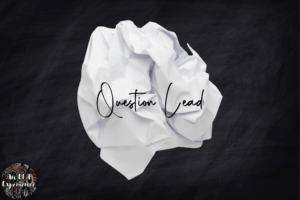
First, think of the ads that open with questions such as “Have you ever looked for a cruise online?” or “Do you want to test your IQ?” How do you respond? I bet you don’t say, “Yes, tell me more.” In fact, if you’re like me, you aren’t hooked but do get a little pleasure from responding with a definite no.
Second, consider state tests with prompts like “Write an essay explaining the importance of a positive attitude.” How many students will turn that prompt into a question and start their compositions with “Do you know why it’s important to have a positive attitude?” And when they do this, they’ll sound like thousands of other students, losing voice and originality.
Don’t get me wrong. The question lead is not banned in my classroom. However, if students use it, then they must write one that hooks readers and makes them think.
This post is a continuation of blogs two and four, which focused on personal narratives, but the hooks I discuss will work with any genre. What’s great about this is you can teach them now and revisit them throughout the year when you’re revising essays, short stories, etc., thereby providing students with time and practice to master these important lines.
Lesson Plan for Writing a Hook
Step 1: Hook Your Students with a Video
Just as writers must hook their readers, teachers need to grab their students’ attention. This lesson uses the 4 Cs (communication, collaboration, creativity, and critical thinking) for rigor and engagement, but I also like to hook students by introducing this lesson with “Writing a Hook,” a video that uses movie clips to demonstrate ways writers hook readers. (This teacher uses the same leads I do, and the kids like the clips, especially the emotion one. A win-win!)
I introduce the video by informing students that we will be studying and writing five of the hooks noted in the video.
After viewing, we discuss what a hook (aka lead) is–the first lines of the introduction meant to reel the reader in.

I follow this with a couple of questions:
- When you’re reading a required text, what makes you want to stop reading?
- What makes you want to continue reading?
Step Two: Introduce 5 Types of Hooks for an Essay
Next, we continue with the slideshow where we’ll discuss five types of hooks with examples.
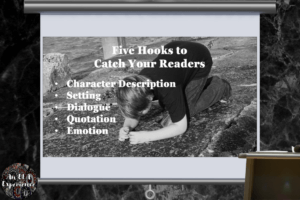
1) Writing a Hook with a Character Description
When you start noticing leads, you’ll discover this one (along with the setting) are popular in narrative writing (because of the exposition). With character description, writers describe the character. They can describe the character’s appearance or give readers an insight into the character as Poe does with his narrator in “The Tell-Tale Heart.”

“TRUE!—nervous—very, very dreadfully nervous I had been and am; but why will you say that I am mad? The disease had sharpened my senses—not destroyed—not dulled them. Above all was the sense of hearing acute. I heard all things in the heaven and in the earth. I heard many things in hell. How, then, am I mad?”
2) Writing a Hook with a Setting
With the setting hook, writers describe the setting as seen in Anna Sewell’s Black Beauty.
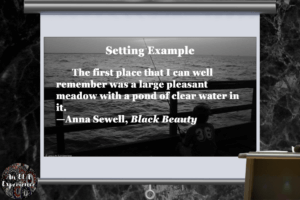
The first place that I can well remember was a large pleasant meadow with a pond of clear water in it.
3) Writing a Hook with Dialogue
When writing a dialogue hook, writers create a conversation between two or more people. (Young writers should stick to two, no more than three, and the dialogue should hook the reader and be important to the story or essay.)
At the end of the dialogue, students need to transition into the writing as seen in the last paragraph of Louisa May Alcott’s Little Men: Life at Plumfield with Jo’s Boys.

“Please, sir, is this Plumfield?” asked a ragged boy of the man who opened the great gate at which the omnibus left him.
“Yes. Who sent you?”
“Mr. Laurence. I have got a letter for the lady.”
“All right; go up to the house, and give it to her; she’ll see to you, little chap.”
The man spoke pleasantly, and the boy went on, feeling much cheered by the words.
4) Writing a Hook with a Quote
A quotation hook quotes one person. The quote can be from someone famous, but it doesn’t have to be. (I used a quotation lead for this post, and I intentionally quoted myself on a topic that would be controversial in order to get your attention. If you’re reading this, then it worked, and it’s for an informational text. Yea!)
In Fitzgerald’s example from The Great Gatsby, the narrator quotes his father. As with the dialogue example, he then transitions into his story.
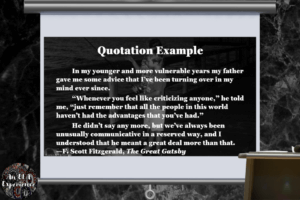
“In my younger and more vulnerable years my father gave me some advice that I’ve been turning over in my mind ever since.
‘Whenever you feel like criticizing anyone,’ he told me, ‘just remember that all the people in this world haven’t had the advantages that you’ve had.’
He didn’t say any more, but we’ve always been unusually communicative in a reserved way, and I understood that he meant a great deal more than that.”
5) Writing a Hook with Emotion
This hook describes the emotions of a character as seen in Aleister Crowley’s example.
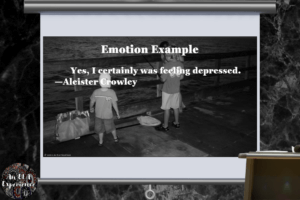
Yes, I certainly was feeling depressed.
Step 3: Quiz Students with a Review of the 5 Types of Hooks
At this time, I give students handouts of the types of hooks we discussed and have them tape them into their writers’ notebooks. By doing this, they can refer to them during our lead review and their writing time.
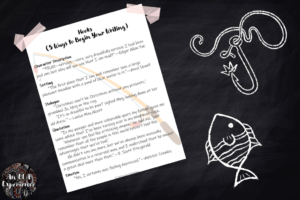
Next, we review these hooks with a few more examples. For this part of the lesson, students will determine which type of hook is being used, why it is or isn’t attention-getting, the difference between a dialogue and quotation lead, etc. I’ll also show them an example of a lead that combines three hook types into one.
Step 4: Ask Students to Write Hooks
Now we move on to the assignment. Students will rewrite their original leads twice, using two of the types of hooks we discussed. (If you used the lessons from blog #4, “Teach Students How to Write Personal Narratives with Graphic Organizers,” then students should have a setting or character description hook. Still, I have them revise and ask them to try to make it even better.)

Modeling will help them do this, so I’ll show them how I revised my lead with all five types of hooks.
For example, my original lead said, “In the summer of 1971, when imagination ruled our days, my little sister and I spent hours, as many kids did, creating stories for our dolls, digging for treasures in our backyard, choreographing dance steps to our favorite songs. So, it’s not surprising that the lone clothes dryer, which sat in the garage centered against the wall, beckoned us to play ‘house,’ to pretend to be adults with a home of our own. It was box-shaped with a round window for a door at its front, making it look like a child’s playhouse.”
My revision for the emotion hook says, “I was scared, not scared about dying from a lack of oxygen that one might experience from being trapped in a clothes dryer, not scared of a heat stroke that might happen since the dryer sat outside a Texas home during the summer. No, I was too young to realize those dangers. Instead, I was afraid of what my father would do when he discovered what I’d been up to.”
Step 5: Allow Time for Peer Conferencing
After ten or fifteen minutes, when students have finished writing their new hooks, I put them into groups of three or four to collaborate. Each student reads their original and revised leads to their group members while group members comment on their leads.

Since I want to make these peer conferences positive, enjoyable experiences for students, I hand out sticky notes or 3 x 3-inch cards with sentence stems that say, “I like your ____________ hook the best. It grabs the reader’s attention by ___________________.” Later in the year, I’ll move on to other feedback strategies, but at this point, students need positive comments and models of how to do that.
If your students are remote, you can use the discussion board on the learning management system your school utilizes for peer conferencing. Here, students can post their hooks and comment on their peers’ hooks. (Over the years, my district moved from Edmodo to Google Classroom to Schoology.)
After students have finished conferencing, I bring the class back together and allow a few to read their leads to the class. I also remind them that they are the authors of their stories, so they ultimately decide which hook to use for their writing.
Step 6: Closing the Writing-a-Hook Lesson
Close the lesson with a brain dump where you discuss what works and doesn’t work when writing a lead.
Related Links
If you’d like my guided slideshow and PDF handouts for this lesson, visit my TPT store: Personal Narrative Hooks.
To move into revising for idea development, visit “Blog #6: 5 Proven Methods for Developing Ideas in Writing.”
To read more about hooks, visit Melissa Burch’s blog post: “Hooks in Narrative Writing and 6 Types of Hooks to Engage Readers.”
Here’s a lesson plan similar to mine. That’s why I like it. Great minds. 😉 “Lesson Plan to Teach Attention Grabbers in Writing”
Visit my second blog post if your students need a topic: “Find Authentic Topics for a Personal Narrative with These 5 Powerful Strategies.”
Share Your Hooks!
I hope you and your students have fun with these activities! Next week, I’ll share more lessons on revising, and we’ll start finishing up the personal narrative.
In the meantime, share your best student hooks with me. I want to know how your kids responded to this writing-a-hook lesson!

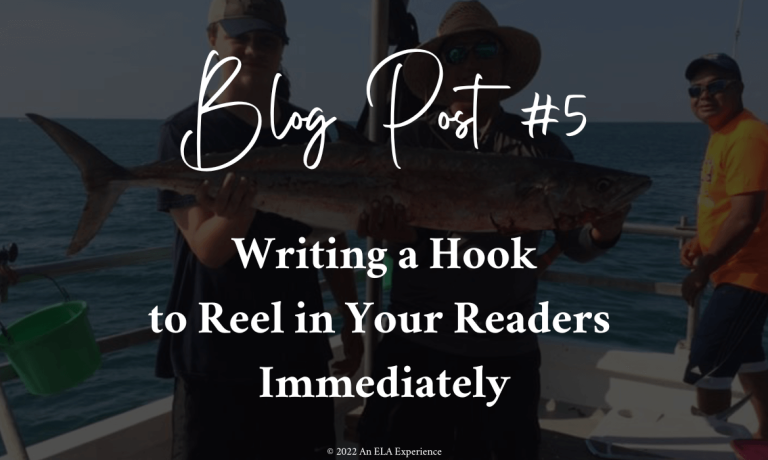

One Response